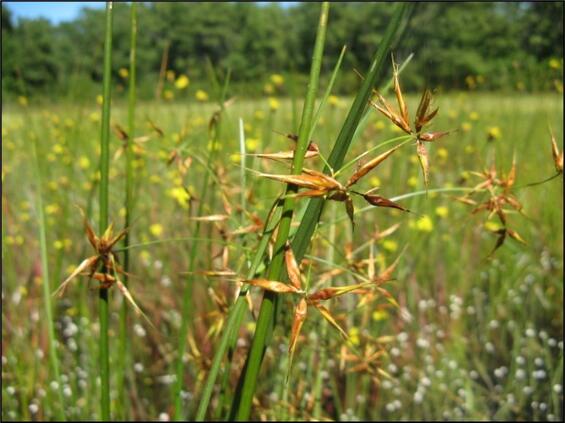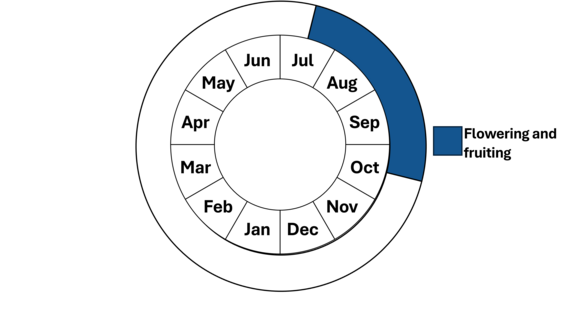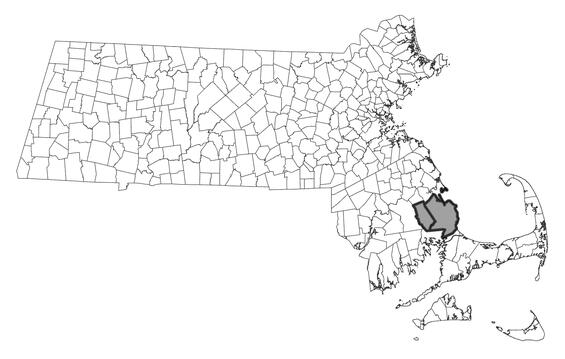- Scientific name: Rhynchospora inundata (Oakes) Fernald
- Species of Greatest Conservation Need (MA State Wildlife Action Plan)
- Threatened (MA Endangered Species Act)
Description

Inundated beaksedge has open clusters of coppery spikelets. Photo credit: Jennifer Garrett
Inundated beaksedge is a large perennial species in the sedge family (Cyperaceae), reaching 20-60 cm (7.9-23.6 in) tall. Plants form extensive loose colonies spreading in shallow water by underground rhizomes. The upright flowering stem (or culm) is triangular in cross-section and is often overtopped by narrow leaves and leafy bracts. The terminal and axillary inflorescences are branched and loosely spreading, with open clusters of 1 to 6 coppery spikelets. Plants generally produce 1 or 2 achenes (dry, one-seeded fruits) per spikelet. The achenes are subtended by bristles and capped by a long horn or beak. The achene with its bristles and horn is enveloped by several overlapping coppery scales. Each fruiting stem may produce 100 to 200 long-lived seeds that require drying and exposure of pondshore substrate for germination. Rhynchospora derives its name from the Greek words rhynchos for beak or horn and spora for seed. The specific epithet inundata refers to the species’ dependence on flooding and changing water levels. This species has several common names including inundated horned-sedge, inundated beak-rush, and drowned horn-rush.
Leaves are slender, erect, and flat or slightly inrolled (4-7 mm; 0.16-0.28 in wide). Most leaves originate at the base of the stem. The loosely branching inflorescence is 10-25 cm (3.9-9.8 in) in diameter. The achene (4-6 mm long; 0.16-0.24 in, 2-3.5 mm wide; 0.08-0.14 in) is subtended by 5 to 6 bristles that extend beyond the achene and are approximately 8-9 mm (0.31-0.35 in) long. At the top of the achene is a very long 14-19 mm (0.55-0.75 in) awl-shaped horn, also called a beak or tubercle.
Inundated beaksedge is similar in appearance and sometimes confused with the more common species, big-headed beaksedge (Rhynchospora macrostachya). Big-headed beaksedge grows in thick tussocks rather than loose colonies, is taller (1-2 m; 39.4-78.7 in), has broader leaves (1 cm; 0.39 in wide), and has denser clusters of spikelets within the terminal inflorescence and leaf axils (up to 10-50 spikelets per cluster). Big-headed beaksedge is more common in Massachusetts and is usually found in coastal plain ponds in slightly higher and drier portions of the shoreline. Broadfruit beaksedge (Rhynchospora careyana) sometimes intergrades with inundated beaksedge to the south but does not occur in New England.
Life cycle and behavior
This is a perennial species.

Population status
Inundated beaksedge is listed under the Massachusetts Endangered Species Act as threatened. All listed species are protected from killing, collecting, possessing, or sale, and from activities that would destroy habitat and thus directly or indirectly cause mortality or disrupt critical behaviors. Inundated beaksedge has 5 occurrence which have been verified since 1999. It has only been observed in Plymouth County in the last 25 years. There is one historical record from Barnstable County. None of the populations are very large.
Distribution and abundance
Inundated beaksedge is native to eastern North America along the Atlantic coastal plain from southeastern Massachusetts to Florida. It also occurs in portions of the Gulf coastal plain in western Florida and Alabama. It is considered rare throughout its range north of the Carolinas.

Distribution in Massachusetts
1999-2024
Based on records in the Natural Heritage Database
Habitat
Inundated beaksedge is an obligate wetland species found on peaty or mucky shores of shallow freshwater coastal plain ponds. This species requires variable periods of inundation and drawdown to complete its life cycle. Inundated beaksedge often produces viable seeds during periods of inundation. The barbed bristles on the achenes expand in water to keep the achenes afloat, thereby dispersing the hard-seeded fruits throughout the pond. Achenes may remain dormant in the seed bank for years until water levels recede and moist substrates are exposed. Seeds require a period of drying and exposure to germinate.
Plants associated with inundated beaksedge within the pond shore zone of frequent inundation and less frequent drawdown include bayonet rush (Juncus militaris), Canada rush (Juncus canadensis), water bulrush (Schoenoplectus subterminalis), water lobelia (Lobelia dortmanna), spike-sedge (Eleocharis tuberculosa), and white beak-sedge (Rhynchospora alba). Inundated beaksedge may occur with other state-listed species such as Plymouth gentian (Sabatia kennedyana), long-beaked beaksedge (Rhynchospora scirpoides), and terete arrowhead (Sagittaria teres).
Healthy habitats are vital for supporting native wildlife and plants. Explore habitats and learn about conservation and restoration in Massachusetts.
Threats
Artificial withdrawal of water and other changes in ground and surface water hydrology may change the specialized cycle of flooding and drawdown required by inundated beaksedge. Invasive species and eutrophication may also become threats. Mud-mat was recently discovered in central Massachusetts and could potentially pose a threat to inundated beaksedge by dominating exposed pond sediments critical for seed germination.
Conservation
Extant populations should be monitored to gain a better understanding of population dynamics, cycles of flooding and drawdown, and current threats. Sites that supported inundated beaksedge historically should also be surveyed periodically, as this species may persist in the seed bank for many years until drawdown conditions are suitable for germination. Off-road vehicles and excessive foot traffic or recreational use should be prohibited in coastal plain pondshore habitats. Best management practices should be implemented to prevent or reduce nutrient enrichment of coastal plain ponds from lawn fertilizers, faulty septic systems, and flocks of grazing ducks or geese. Currently, there are no known threats from invasive plants. However, monitoring for invasive species such as mud-mat (Glossostigma cleistanthum)may allow for early detection and control. All active management of rare plant populations (including invasive species removal) is subject to review under the Massachusetts Endangered Species Act and should be planned in close consultation with the MassWildlife’s Natural Heritage & Endangered Species Program.
References
Craine, S.I. 2003. Rhynchospora inundata (Oakes) Fern. (Inundated Beak-rush) Conservation and Research Plan for New England. New England Wild Flower Society, Framingham, MA.
Fernald, M.L. 1950. Gray’s Manual of Botany, 8th edition. American Book Company, Boston, MA.
NatureServe. 2025. NatureServe Network Biodiversity Location Data accessed through NatureServe Explorer [web application]. NatureServe, Arlington, Virginia. Available https://explorer.natureserve.org/. Accessed: 5/27/2025.
Reznicek, A.A., J.E. Fairey, and A.T. Whittemore. 2002. Rhynchospora. R. Kral. Pages 200-208 in Flora of North America Editorial Committee (Editors), Flora of North America north of Mexico, Volume 23. Cyperaceae. Oxford University Press, NY.
Contact
| Date published: | May 7, 2025 |
|---|